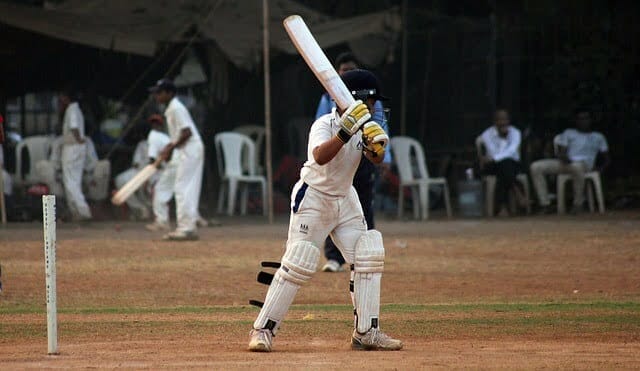Batting is a very technical thing, far more technically demanding than most sporting endeavors. It is physically demanding and the mental element is also very crucial. A peculiarly demanding element is the question of time and not just in the context of strike rates and targets.
One of the World Cup TV commentators – Pommie Mbangwa?- recently quoted the philosopher Herschelle Gibbs saying that opening the innings was the easiest job in cricket because the situation was always the same. You can see what he means. If you bat at, say, number five, you are never sure what the situation is going to be when you go in. But when you open the situation is crystal clear , and the bowlers have no advantage over you.
In this respect batting is a unique sporting phenomenon. In all other sporting contexts – let’ s ignore baseball , which is similar but not identical – everybody turns up and leaves at the same time. It doesn’t matter whether it is a team game or an individual one – soccer, rugby, tennis, golf, badminton , tiddlywinks – people might be doing different things but they are doing them together. In cricket the same is true of the fielding side. People are doing different things – some will bowl, one is keeping wicket, some are close fielders; but there is a collective effor – barring injury they all arrive and leave together.
Batting is an individual process in its relation to time as well as everything else. The pivotal number three position – favoured by Don Bradman and Viv Richards, the greatest batsmen of the twentieth century – illustrates this.
When Ricky Ponting won the toss and elected to bat against England on a belter at the Adelaide Oval in December 2010 he found himself facing the fifth ball of the match, delivered by James Anderson , after Simon Katich had been run out without facing a ball. Ponting was out in Anderson’s next over; Australia never recovered , going on to lose the match and the series. Twenty years or so earlier , in 1989 Ponting’s distinguished Tasmanian forerunner , David Boon , had had a highly addictive successful Ashes series as number three,scoring over four hundred runs at an average of fifty five. But he spent the first day of the fifth Test at Trent Bridge sitting in the dressing room with his pads on watching Geoff Marsh and Mark Taylor put on 301 for the first wicket. You just don’t know what is going to happen.
Test cricket is peculiarly susceptible to the vagaries of time but the World Cup encounter between West Indies and Zimbabwe at Canberra illustrated the games that time can play with batsmen, in this case the West Indies top four of Dwayne Smith , Chris Gayle, Marlon Samuels and Jonathan Carter.
Smith and Gayle opened after Dinesh Ramdin had won the toss and opted to bat. Smith faced the first ball from Tinashe Panyangara. Full and outside off, Smith let it go – a surprise as he is not generally regarded as a member of the Ian Bell school of one- day opening. The next ball was fuller and straighter and it cleaned Smith up. That was it for him : just the long and lonely walk back to the pavilion.
So Samuels was in to face the third ball of the match. That’s the thing about batting number three: you might effectively be opening the innings. So while when Smith and Gayle went in it was just the normal start of the innings, when Samuels joined Gayle two balls later there was something like a crisis.
We all know what happened. The second-wicket pair started slowly, even scratching – when drinks were taken after seventeen overs the score was seventy three for one, with Gayle on forty one ( with one six) and Samuels on twenty seven . Around the twenty fifth over Gayle really started to get going but his remarkable display of hitting meant that Samuels could afford to take his time until the ” death” overs. In the last seven overs of the innings they belted 114 runs, finishing on 372 for one, Gayle 216, Samuels 137 not out.
And Jonathan Carter..? Jonathan who?
I thought you might ask. Carter is a twenty seven year old left hander from Barbados who was down to bat at four. He had played five one day internationals , all earlier this year against South Africa and had a highest score of forty.
Carter was playing in this game because Darren Bravo had pulled a hamstring in the match against Pakistan. So this was a huge deal for Carter , a World Cup encounter with one of the minnows and batting at four.
His heart must have been in his mouth as Samuels walked out. Samuels got a single off his first ball and Gayle prepared to face Panyangara. His first ball had him what appeared to be plumb in front . There was a huge appeal: not out. The Zimbabweans referred it: not out. But it could so easily have been one for two.
But it wasn’t ‘t. Carter had to sit and wait. In the seventeenth over Samuels was dropped. Again Carter must have instinctively reached for his gloves and helmet. But no. More waiting. If you are number six, say, you can switch off a bit. But as next man in there is nowhere to go. Just wait – it’s your turn next.
By about the fortieth over , at the latest, Carte’s natural anxiety had probably morphed into something slightly different : a realization that, even if a wicket were to fall, it would not be him going out to replace his departing colleague. It would not be the rookie; it would be a ” finisher” like Andre Russell or Darren Sammy.
As it happened, Gayle was eventually out. To the last ball of the innings.
Four batsmen, four quite different experiences. All of them on their own despite a 372 run partnership.
At the final on 29 March two opening batsmen – who knows, maybe Smith and Gayle – will walk out to open the innings before 90,000 cheering fans. Despite all the mid pitch chat and glove tapping each man will be on his own.
It’s a bit like the feeling expressed by the immortal Barry Humphries, after a busy day , getting ready in his dressing room and then walking out to face a packed house in a darkened Drury Lane auditorium.
” Alone at last!”
Bill Ricquier, 27/2/2015
This article was posted in ESPN Cricinfo: http://www.espncricinfo.com/thestands/content/story/840003.html




